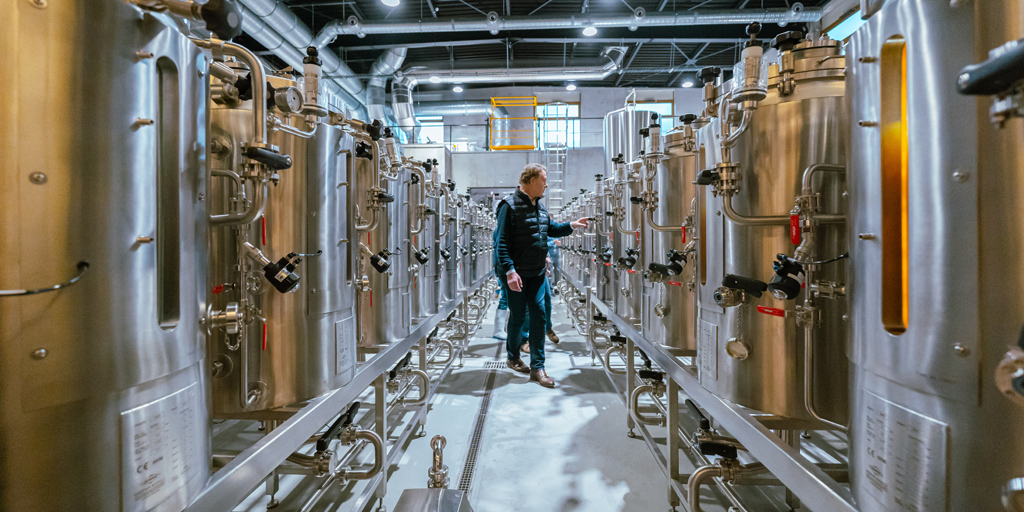
Ongoing research yields results in yeast flexibility

The Technical Hall at the Fermentis Campus, Lille, where Fermentis undertakes its characterisation research.
Ongoing research by Fermentis into the impact that its yeast has on the other ingredients of beer continues to reveal new applications for its products.
In a BreweryPro conversation with Brews News editor Matt Kirkegaard, Fermentis’ Sensory Manager Gabriela Montandon discussed some of the company’s recent discoveries, including the dynamic nature of its SafAle™ K-97 yeast.
During the conversation, Montandon, who has a PhD in microbiology and more than a decade’s experience in sensory analysis of beer, said that contrary to popular opinion yeast can’t fairly be described as a “simple organism”.
“I must challenge that idea,” she said in the episode. “I think we want yeast to be simple but it’s a little different than what it really is.”
She said that while yeast are only one cell, they do everything that is involved in fermentation in that one cell.
“I think because it’s invisible, it’s unknown, it’s mysterious, that we don’t have the total understanding of what the impact is by simply choosing the right or the wrong yeast to brew a specific recipe.”
She said that using yeast well isn’t just opening a packet and creating the right environment for yeast in the wort.
“Since it’s this mysterious environment, characterising yeast has opened up our comprehension because one of the important points to take into consideration is those yeast are incredible, they are diverse in their genomic terms,” she says.
“But the moment we go deep into understanding how yeasts behave when we play with variables like the density of the wort, when we play with under or over-pitching into the wort, we play with temperature of fermentation, this is the way we give the yeast the environment to produce things we want or we don’t want to and every yeast may react differently.”
Because of this complexity and variability under different conditions, Fermentis invests heavily in research and Montandon leads the team that characterises its yeast.
“We have been characterising nearly all of our portfolio of brewing yeasts, which lets us compare how one behaves in the same conditions or a variety of conditions to another yeast,” she explained.
“So, we have yeasts that are more or less sensitive to the temperature of fermentation, meaning that when we are increasing the temperature some yeast will promote or produce specific components that will have more or less impact in the final beer.
“We also have yeast that, by increasing the fermentation temperature even 10 degrees Celsius more than we usually do, there is nearly no impact on the final beer.
“So what we do is we really play with that conditions where we put the yeast and we evaluate what happens to the beer chemically but also in sensory perspective.”
The small scale that Fermentis works with in its new pilot brewery at its Campus in Lille, France, has given the company great insight into how its yeasts perform sensorily under a range of different conditions and recipes.
As part of the characterisation trials, Montandon has found that one of its yeasts, SafAle™ K-97, which has traditionally been used in more delicate beer styles such as Kolsch, has much wider applications with hoppy beers.
“Brewers know that using other ingredients, such as pilsner malt or cascade hops, that they can have a wide application across many styles, not just one,” Montandon says. “And it’s the same for yeast.”
“What you need to know is what that yeast will bring to you, and K-97 is very good at producing Kolsch-style beers.
“But by characterising the yeast, by really digging into the yeast’s potential as we have for several years, we have shown that the yeast has a significant impact when interacting with hops.
“We have demonstrated that the yeast will take hop components that were invisible, they were flavour inactive in that form, and they will transform that hop component and release what is flavour active.
“We call that biotransformation because you need to transform it through a biological creature, such as yeast.”
Montandon said the characterisation trials had demonstrated SafAle™ K-97’s ability to substantially release bound hop thiols, making it a useful tool for heavily hopped beers such as hazy IPAs.
Listen to the full conversation about yeast characterisation and Fermentis’ discoveries here.
This Tradeshow article was presented in partnership with Fermentis and Bintani. To better communicate your products and services to our audience of brewing industry professionals, contact us here.




